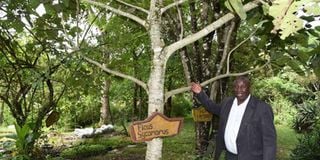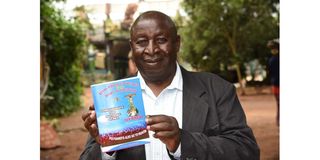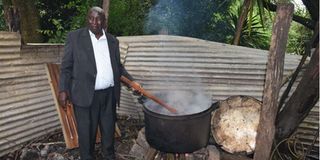Premium
Kitale conservationist takes a different path, and it's paying off

Boniface Ndura Komburi, proprietor of Kitale Nature Conservancy in Trans Nzoia County, shows Ficus Sycomorus tree, on June 09, 2018. He has planted 600-700 tree species at his botanical garden and most of them are medicinal.
What you need to know:
- The conservancy hosts a botanical park, which boasts of between 600 and 700 different plant species.
- The indigenous plant species have been grouped according to family species.
As wildlife and indigenous trees face the risk of extinction due to human-wildlife conflict, one man in Trans-Nzoia County is on a mission to save them.
He has set up a haven for flora and fauna at Kitale Nature Conservancy, off the Kitale-Kapenguria road.
A former primary school mathematics teacher, Boniface Ndura’s love for environmental conservation has seen him put up a nature conservancy on a 200-acre piece of land surrounded by hundreds of indigenous plants.
The conservancy hosts a botanical park, which boasts of between 600 and 700 different plant species that he collected from various parts of the country.
“I travelled all over the country to collect various plants... I am convinced that it is important to conserve these plants some of which face extinction,” he says.
The indigenous plant species have been grouped according to family species. They include Cider of Lebanon, Ficus Sycomorus and Euphoria Tirucalli. There are also some Gardenia species like Gardenia Ternifolia and Gardenia Posoqueria.
Ndura was first posted to a school in Limuru, Kiambu County, after graduating in 1971 from Kilimambogo Teachers College. He taught mathematics for 27 years (from 1971 to 1998) before he retired to concentrate on his conservation efforts.
It is his unrivalled passion for flora and fauna that saw him relocate from Limuru to Trans Nzoia in 1983 in search of vast land to focus on private nature conservation activities. He started with just two acres of land from his savings but expanded with time.
“The savings from my salary and micro-finance business formed the capital that I used to buy two acres of land to start a botanical garden,” said Mr Ndura as he took us around what is now 200 acres of the vast Kitale Nature Conservancy.
“When I started, an acre of land was going for Sh20,000 and I had to put in place a clear investment plan. It includes assembling different species of plants from across the country, translating to almost Sh100,000 as the starting capital,” explained Mr Ndura.
It is a breathtaking place that is also shrouded in mystery. It is home to some animals that suffer from conditions such as dwarfism, elephantiasis, twisted neck, hernia and a short tail. It also hosts arguably one of the largest botanical gardens in the country.

Boniface Ndura Komburi, proprietor of Kitale Nature Conservancy in Trans Nzoia County, displays a book he authored, about his discovery of medicine he said treats cancer among other diseases, on June 09, 2018.
Deformed animals
The passion for nature saw the mathematics teacher-turned-conservationist advance to the protection of animals with deformities.
“Having land to keep the animals was my main challenge. I had to save enough and expand this piece of land progressively to 10 acres before bringing in these deformed animals as part of my conservation work,” said Mr Ndura.
In 2,000, he decided to venture into an unfamiliar territory when he bought a deformed cow with one eye, four horns and a distorted mouth at Sh40,000.
Initially, he used to look for deformed animals but when people realised that there was a place they could sell them, they slowly began looking for the conservationist.
But it was not all rosy. Despite his passion for nature, not everyone was happy with his decision.
The 71-year-old recounts that neighbours used to associate the deformed animals with any bad events that occurred.
“Some thought I was a mad man. Most people here associate these creatures with bad omen, some form of a curse. When there was no rain or if lightning killed livestock in the area, neighbours came and demanded that I should relocate the animals from there,” he recalls.
But with time, Mr Ndura says, the neighbours started to appreciate his work and even flocked to see the bizarre animals.
This motivated him to expand the park from the little he got from the visits.
And to enable him to get the deformed animals, he doubles the amount to make the business lucrative. For instance, if a cow costs Sh20,000, he bought it off for Sh40,000.
“Any initiative that doesn’t involve the youth is bound to fail but if you want to succeed, you must involve them. It is crucial to nurture conservation culture at the tender age so that they interact with the animals early and curb poaching,” says the conservationist.
Nature lovers usually part with Sh150 per person and the park has recorded a gradual rise in the number of visitors, mainly local tourists. At its peak, this park has hosted a total of 58 schools in a single day.
Some of the domestic animals, cows, a donkey and sheep, suffer from various deformities related to the reproductive systems that are linked to environmental factors.
Three heifers have a misplaced vulva between the hind legs, a puzzle, he argues, requires Kenyan and international scientists to study.
“Most of these conditions are shared between humans and animals. There is a need to find the link of the mutation before it crosses to humans because, if it happens, then it will be the end of the human race,” says Mr Ndura.
This, he says, will ensure that scientists develop a data bank, which is non-existent at the moment.

Boniface Ndura Komburi, proprietor of Kitale Nature Conservancy in Trans Nzoia County, prepares “Hyssop” herbal medicine he said treats cancer among other diseases, on June 09, 2018. He has planted 600-700 tree species most of them are medicinal.
Head of State Award
His environmental efforts have paid off and in 2010 he was awarded the Head of State Commendation award (civilian division) in by former President Mwai Kibaki.
In 2014, he was named a hero by Trans Nzoia County government joining other prominent Kenyans who have contributed immensely to the country’s development.
But not all of the animals have deformities as there are also Friesian and the brown-skinned and big-horned Ankole breed of cattle, which are native from Uganda without mutations.
He says that he decided to keep the cows without deformities to share information that most of them are affected by climate change and ''we should not completely abandon indigenous domestic animals, which are drought tolerant and disease resistant.''
In 2013, he applied for a licence from Kenya Wildlife Service to keep wild animals and he was given the green light.
Now the park hosts two lions, tortoises, ostriches, baboons, rock hyrax, hyena, crocodiles and some bird species.
The two lions were donated by the Nairobi National Park last year.
He is among the first people in Trans Nzoia and Western region to rear the rock hyrax that is mainly found in rocky areas and cane rats, found in sugarcane growing areas. He is on a race to save them from imminent extinction.
“We want our children to interact with animals early so they can actively participate in the conservation of our environment,” says Mr Ndura.
“Animals that are domesticated like cows are not facing extinction but animals that live alone in the wild are likely to be extinct. That is why it is important for us to also start to domesticate some of these wild animals,” he said.






